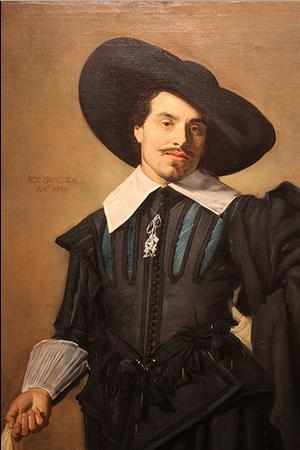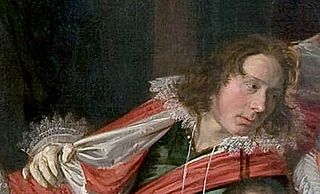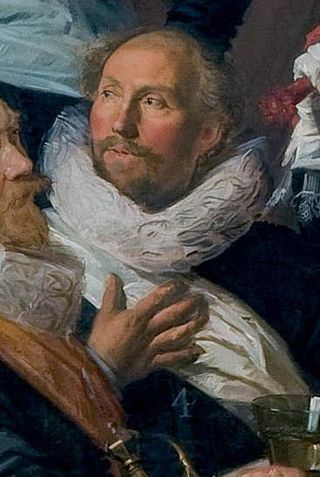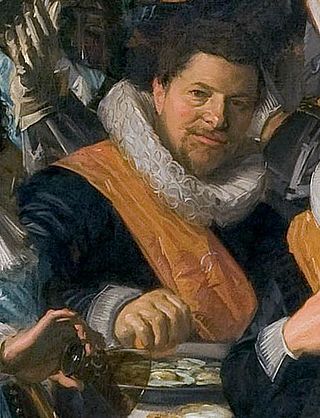
Frans Hals the Elder was a Dutch Golden Age painter. He lived and worked in Haarlem, a city in which the local authority of the day frowned on religious painting in places of worship but citizens liked to decorate their homes with works of art. Hals was highly sought after by wealthy burgher commissioners of individual, married-couple, family, and institutional-group portraits. He also painted tronies for the general market.

The Banquet of the Officers of the St George Militia Company in 1616 refers to the first of several large schutterstukken painted by the Dutch painter Frans Hals for the St. George civic guard of Haarlem, and today is considered one of the main attractions of the Frans Hals Museum, Haarlem.

Jacob Pietersz Olycan, was a brewer, magistrate, and later mayor of Haarlem, best known today for his portrait by Frans Hals, pendant to the portrait of Aletta Hannemans, whom he married in Zwolle in 1624.

Banquet of the officers of the Calivermen Civic Guard, Haarlem formerly known as The Banquet of the Officers of the St Adrian Militia Company in 1627, refers to a schutterstuk painted by Frans Hals, in 1627, for the St. Adrian civic guard of Haarlem. Today it is considered one of the main attractions of the Frans Hals Museum, in Haarlem.

The Officers of the St Adrian Militia Company in 1633 refers to the second schutterstuk painted by Frans Hals for the Cluveniers, St. Adrian, or St. Hadrian civic guard of Haarlem, in 1633, and today considered one of the main attractions of the Frans Hals Museum there.

The Officers of the St Adrian Militia Company in 1630 refers to the schutterstuk painted by Hendrik Gerritsz Pot for the Cluveniers, St. Adrian, or St. Hadrian civic guard of Haarlem, and today is considered one of the main attractions of the Frans Hals Museum there.

The Officers of the St George Militia Company in 1639 refers to the last and largest schuttersstuk painted by Frans Hals for the St. George civic guard of Haarlem, and today is considered one of the main attractions of the Frans Hals Museum in Haarlem.

Michiel de Wael, was a Dutch brewer and citizen of Haarlem, best known today for his portraits painted by Frans Hals. His grandfather, also a brewer, was one of the first Calvinists in the city and was involved in the Siege of Haarlem.

The Haarlem schutterij refers to a collective name for the voluntary civic guard of Haarlem, from medieval times up to the Batavian Revolution in 1794, when the guilds of Haarlem were disbanded.

Willem Claesz Vooght (1572–1630), was a mayor of Haarlem best known today for the portrait painted of him by the painter Frans Hals.

Cornelis Coning or Koning, was an engraver and mayor of Haarlem.

Jacob Cornelisz Schout, was a Dutch Golden Age member of the Haarlem schutterij.
Boudewijn van Offenberg or Offenberch (1590–1653), was a Dutch Golden Age notary, merchant and member of the Haarlem schutterij.

Nicolaes Adriaensz. Verbeek (1582–1637), was a Dutch Golden Age brewer of Haarlem.

Cornelis Boudewijns van Lockhorst, was a Dutch Golden Age brewer of Haarlem.

Frederik Coning, was a Dutch Golden Age member of the Haarlem schutterij.

Nicolaes le Febure was a Dutch Golden Age mayor of Haarlem.

Johan Damius, was a Dutch Golden Age member of the Haarlem schutterij.

Pieter Ramp, was a Dutch Golden Age member of the Haarlem schutterij.

Johan Schatter, was a Dutch Golden Age brewer from Haarlem.























